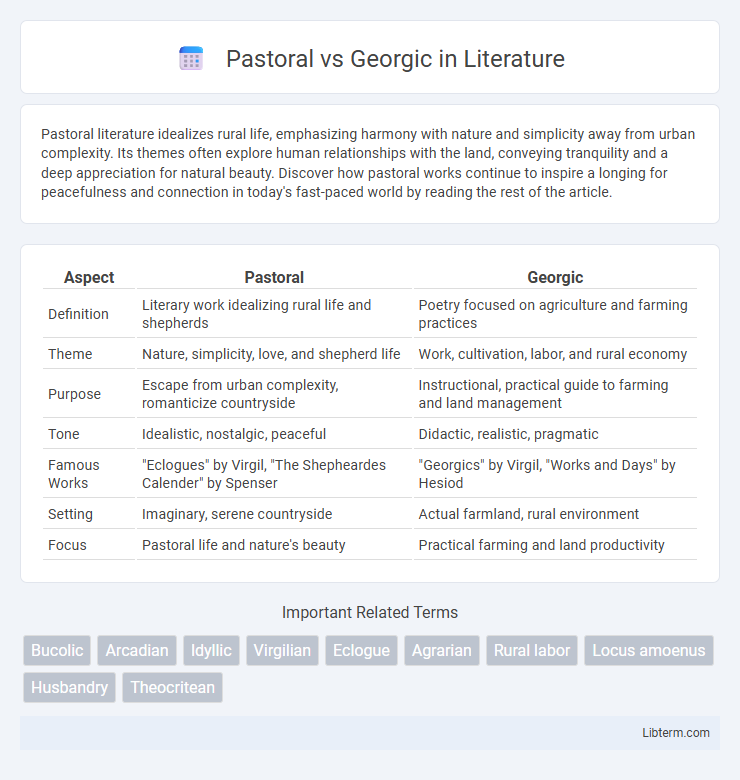Pastoral literature idealizes rural life, emphasizing harmony with nature and simplicity away from urban complexity. Its themes often explore human relationships with the land, conveying tranquility and a deep appreciation for natural beauty. Discover how pastoral works continue to inspire a longing for peacefulness and connection in today's fast-paced world by reading the rest of the article.
Table of Comparison
| Aspect | Pastoral | Georgic |
|---|---|---|
| Definition | Literary work idealizing rural life and shepherds | Poetry focused on agriculture and farming practices |
| Theme | Nature, simplicity, love, and shepherd life | Work, cultivation, labor, and rural economy |
| Purpose | Escape from urban complexity, romanticize countryside | Instructional, practical guide to farming and land management |
| Tone | Idealistic, nostalgic, peaceful | Didactic, realistic, pragmatic |
| Famous Works | "Eclogues" by Virgil, "The Shepheardes Calender" by Spenser | "Georgics" by Virgil, "Works and Days" by Hesiod |
| Setting | Imaginary, serene countryside | Actual farmland, rural environment |
| Focus | Pastoral life and nature's beauty | Practical farming and land productivity |
Defining Pastoral and Georgic Poetry
Pastoral poetry idealizes rural life through depictions of shepherds and nature, emphasizing simplicity and harmony with the natural world. Georgic poetry, rooted in agricultural themes, offers practical advice and reflections on farming, labor, and the relationship between humans and the earth. Both genres originate from classical literature but differ in tone and purpose, with pastoral centering on leisure and Georgic on productive labor.
Historical Origins and Development
Pastoral poetry originated in ancient Greece, with Theocritus in the 3rd century BCE pioneering idyllic representations of shepherd life, while the Roman poet Virgil further developed this in his "Eclogues," blending rustic themes with classical ideals. Georgic poetry emerged later, notably through Virgil's "Georgics," written around 29 BCE, focusing on agricultural practices and rural labor, reflecting Roman agrarian values and societal order. Over time, these forms evolved with Renaissance and Enlightenment writers expanding the pastoral's romanticized depictions and the georgic's didactic focus on farming and land stewardship.
Key Themes and Motifs
Pastoral poetry emphasizes idyllic rural life, harmony with nature, and simple shepherd existence, often evoking nostalgia and escapism. Georgic poetry centers on agricultural labor, practical farming techniques, and human interaction with the land, highlighting themes of toil, discipline, and rural economy. Both genres explore humanity's relationship with nature but differ in tone--Pastoral idealizes nature's serenity, while Georgic portrays its challenges and productivity.
Major Authors and Influential Works
Pastoral poetry, characterized by idyllic depictions of rural life, is exemplified by major authors such as Theocritus, whose "Idylls" originated the genre, and Virgil, whose "Eclogues" further shaped pastoral tradition. Georgic poetry, aimed at didactic reflections on agriculture and rural labor, is best represented by Virgil's "Georgics," an influential work that combines practical farming advice with poetic form, and Hesiod, whose "Works and Days" laid foundational themes for georgic literature. These seminal works by Virgil and Hesiod anchor the distinction between pastoral's idealized countryside and georgic's instructional rural focus, heavily influencing subsequent Renaissance and modern poetry.
Literary Techniques and Style
Pastoral poetry uses simple, idealized language and imagery to depict rural life, emphasizing natural harmony through techniques such as allegory and bucolic symbolism. Georgic poetry employs a more didactic style with precise, technical descriptions and practical instructions, often utilizing elevated diction and structured verse to convey agricultural labor. Both styles share classical influences but contrast in tone, with pastorial evoking escapism and georgic stressing instructional realism.
Representation of Nature and Rural Life
Pastoral poetry idealizes nature and rural life by portraying landscapes as peaceful, harmonious settings inhabited by shepherds and simple folk, emphasizing an escapist vision of the countryside. In contrast, Georgic poetry offers a practical and realistic representation of rural labor and agricultural processes, highlighting the hard work and challenges faced by farmers while maintaining respect for the land's productivity. Both genres reflect relationships with nature, but Pastoral prioritizes idyllic simplicity whereas Georgic centers on cultivation and human industry.
Socio-Political Undertones
Pastoral literature idealizes rural life as a symbol of simplicity and harmony, often contrasting with urban corruption and societal decay, reflecting socio-political critiques of contemporary governance and social structures. Georgic poetry, while also centered on rural themes, emphasizes agricultural labor, productivity, and human intervention in nature, symbolizing societal order, resilience, and the virtues of hard work aligned with emerging political ideologies. Both genres engage with socio-political undercurrents by either romanticizing or rationalizing rural existence, offering perspectives on class relations, labor, and governance in their respective historical contexts.
Differences in Tone and Purpose
Pastoral poetry often features an idealized, serene depiction of rural life aimed at evoking nostalgia and tranquility, using a gentle and lyrical tone. Georgic poetry focuses on instructive themes related to agriculture and rural labor, adopting a more practical and didactic tone that emphasizes work ethic and the relationship between humans and nature. These tonal and purposeful distinctions highlight Pastoral poetry's celebration of simplicity and Georgic's promotion of productive engagement with the land.
Pastoral and Georgic in Modern Literature
Pastoral literature, rooted in idealized depictions of rural life and shepherds, contrasts with Georgic works that emphasize agricultural labor and practical land management. In modern literature, Pastoral themes often explore nostalgia and environmental concerns, while Georgic narratives address sustainability and human interaction with nature. Contemporary authors blend these traditions to critique urbanization and reconnect readers with ecological awareness.
Lasting Impact on Literary Tradition
Pastoral poetry, rooted in idealized rural life, profoundly shaped the literary tradition by inspiring themes of nature, simplicity, and escapism that persist in modern literature. Georgic poetry, with its practical and instructional focus on agriculture and rural labor, influenced the development of didactic literature, emphasizing the value of human toil and harmony with the environment. Both genres established enduring frameworks for exploring humanity's relationship to nature, blending aesthetic beauty with moral and practical lessons throughout centuries of literary evolution.
Pastoral Infographic

 libterm.com
libterm.com